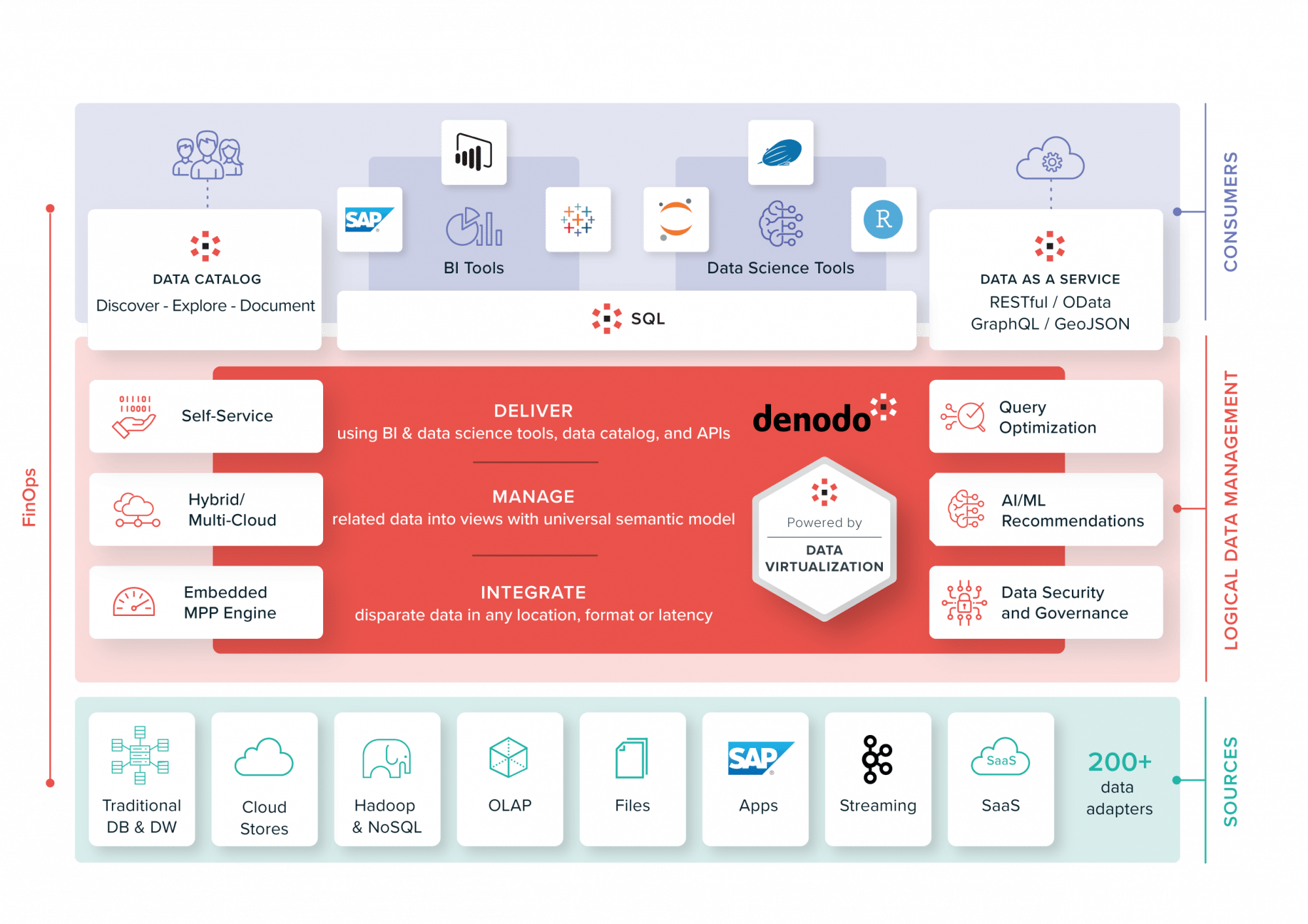Related Resources
In today’s data-driven world, organizations are inundated with vast amounts of data generated from various sources. Efficiently managing and integrating this data has become a critical challenge for Data Analysts, IT Professionals, and Business Intelligence Teams. Enter Denodo—a game-changing solution that offers efficient data virtualization and integration without the need for replication. In this blog post, we’ll explore how Denodo simplifies data access, its key features and benefits, and how it can transform your organization’s data management strategies.
What is Denodo?
For those unfamiliar with Denodo, it’s a powerful data virtualization platform that enables seamless data integration and real-time access from disparate sources. Denodo eliminates the need for data replication, ensuring that data is accessed directly from its original location. With its robust capabilities, Denodo empowers organizations to create a unified view of their data, regardless of where it resides, making it an invaluable tool for modern data management.
Denodo’s core features include data virtualization, advanced integration, centralized data governance, and real-time data access. These capabilities allow businesses to manage their data more effectively, improve decision-making, and enhance overall operational efficiency. By offering a comprehensive approach to data management, Denodo has become a leader in the field of data virtualization.
The Challenges of Traditional Data Integration
Traditional data integration methods, such as Extract, Transform, Load (ETL) and data replication, have long been used to consolidate data from various sources. However, these approaches come with significant limitations. One of the main challenges is the creation of data silos, where data is isolated within different systems, making it difficult to access and integrate efficiently.
Data duplication is another issue associated with traditional methods. Replicating data across multiple systems not only increases storage costs but also leads to inconsistencies and outdated information. Additionally, these processes often involve complex infrastructure and require significant time and resources to maintain. This can result in delays in data delivery, hindering decision-making and reducing overall organizational agility.
How Denodo Solves These Problems with Data Virtualization
Data virtualization allows businesses to create a unified view of their data from multiple sources, eliminating the need for physical data movement.
Denodo addresses the challenges of traditional data integration by leveraging data virtualization to provide efficient data access without replication. Data virtualization allows businesses to create a unified view of their data from multiple sources, eliminating the need for physical data movement. This approach ensures that data is always up-to-date and accessible in real-time, enhancing decision-making and operational efficiency.
With Denodo, organizations can seamlessly integrate data from both on-premise and cloud-based sources. The platform’s ability to access and consolidate data from disparate systems eliminates data silos, providing a holistic view of organizational data. Denodo’s advanced data virtualization capabilities enable businesses to manage their data more effectively, reduce infrastructure complexity, and improve overall data management strategies.
Key Features of Denodo
Denodo’s key features are designed to transform how organizations manage and utilize their data. Let’s explore these features in more detail:
Data Virtualization
Denodo’s data virtualization capabilities provide real-time access to data without moving or replicating it. This feature allows organizations to create a unified view of their data from multiple sources, enhancing decision-making and operational efficiency. By eliminating the need for data replication, Denodo reduces storage costs and ensures that data is always up-to-date.
Advanced Data Integration
Denodo’s platform supports advanced data integration, enabling businesses to integrate data from structured and unstructured sources. This capability allows organizations to consolidate data from various systems, providing a comprehensive view of their data landscape. Denodo’s advanced integration features ensure that data is always accessible and ready for analysis, improving overall data management strategies.
Centralized Data Governance
Denodo’s centralized data governance features enable secure, governed data access, ensuring that data is managed and utilized according to organizational policies and industry standards. This capability allows businesses to maintain data integrity, comply with regulations, and protect sensitive information. Denodo’s centralized data governance features provide organizations with the tools they need to manage their data effectively and securely.
Agility and Flexibility
Denodo’s agile and flexible platform supports agile data management strategies, enabling organizations to adapt quickly to changing business needs. This capability allows businesses to scale their data management efforts as their data demands grow, ensuring that they can continue to meet their organizational goals. Denodo’s agile and flexible platform provides organizations with the tools they need to manage their data more effectively and efficiently.
Security and Compliance
Denodo’s platform ensures data security and compliance, helping organizations adhere to industry standards and regulations. This capability allows businesses to protect sensitive information and maintain data integrity, ensuring that their data is managed and utilized securely. Denodo’s security and compliance features provide organizations with the tools they need to manage their data securely and effectively.
Image Source: Denodo
Benefits of Using Denodo Across the Organization
Implementing Denodo across an organization offers numerous benefits that can enhance overall data management strategies. Let’s explore these benefits in more detail:
Increased Efficiency
Denodo’s platform improves data delivery speed and reduces infrastructure complexity, allowing organizations to manage their data more efficiently. This capability enables businesses to streamline their data management efforts, reducing the time and resources required to access and utilize their data. Denodo’s increased efficiency features provide organizations with the tools they need to manage their data more effectively and efficiently.
Cost Savings
Denodo’s platform offers cost savings by eliminating the need for data replication and reducing storage needs. This capability allows organizations to manage their data more economically, reducing the costs associated with traditional data integration methods. Denodo’s cost savings features provide organizations with the tools they need to manage their data more cost-effectively.
Improved Decision-Making
Denodo’s real-time data access capabilities allow for quicker, better-informed decisions, enhancing overall decision-making processes. This capability enables organizations to access and analyze their data in real-time, providing them with the information they need to make informed decisions. Denodo’s improved decision-making features provide organizations with the tools they need to enhance their decision-making processes.
Seamless Integration Across Systems
Denodo’s platform allows for seamless integration across various platforms, systems, and applications, providing organizations with a comprehensive view of their data landscape. This capability enables businesses to manage their data more effectively, ensuring that they can access and utilize their data across multiple systems. Denodo’s seamless integration features provide organizations with the tools they need to manage their data more effectively and efficiently.
Scalability
Denodo’s platform scales with growing data demands, allowing organizations to manage their data more effectively as their data needs grow. This capability enables businesses to adapt their data management strategies as their data demands increase, ensuring that they can continue to meet their organizational goals. Denodo’s scalability features provide organizations with the tools they need to manage their data more effectively and efficiently.
Use Cases and Industry Examples
Denodo’s platform has been successfully implemented across various industries, providing organizations with the tools they need to manage their data more effectively. Let’s explore some use cases and industry examples:
In the healthcare industry, Denodo has helped organizations streamline data management, improve operational efficiency, and reduce costs. By leveraging Denodo’s data virtualization capabilities, healthcare organizations can access and analyze their data in real-time, providing them with the information they need to make informed decisions.
In the finance industry, Denodo’s platform has enabled organizations to manage their data more effectively, improving overall data management strategies. By leveraging Denodo’s advanced data integration capabilities, finance organizations can consolidate data from various systems, providing them with a comprehensive view of their data landscape.
In the retail industry, Denodo’s platform has helped organizations manage their data more efficiently, enhancing overall data management efforts. By leveraging Denodo’s agile and flexible platform, retail organizations can adapt their data management strategies as their data demands grow, ensuring that they can continue to meet their organizational goals.
Ways to Implement Denodo at Your Workplace
Implementing Denodo in your organization involves several steps, from evaluating current data management systems to deploying a Denodo solution. Let’s explore these steps in more detail:
Evaluate Current Data Management Systems
The first step in implementing Denodo is to evaluate your current data management systems. This involves assessing your organization’s data needs, identifying any data silos, and determining the best approach for integrating Denodo into your existing data management strategies. Once you have a clear understanding of your organization’s data needs, you can begin to develop a plan for implementing Denodo.
Deploy a Denodo Solution
Once you have evaluated your current data management systems, the next step is to deploy a Denodo solution. This involves configuring Denodo to meet your organization’s specific data needs, integrating it with existing systems, and ensuring that it aligns with your overall data management strategies. By deploying a Denodo solution, you can begin to leverage its powerful data virtualization capabilities to enhance your organization’s data management efforts.
Best Practices for Implementation
To maximize the benefits of Denodo’s data virtualization platform, it’s important to follow best practices for implementation. This involves ensuring that Denodo is configured correctly, regularly monitoring its performance, and making any necessary adjustments to optimize its effectiveness. By following best practices for implementation, you can ensure that your organization fully leverages Denodo’s capabilities to enhance its data management strategies.
To Summarize
In conclusion, Denodo offers a powerful solution for efficient data virtualization and integration without replication, providing organizations with the tools they need to manage their data more effectively. By leveraging Denodo’s advanced capabilities, businesses can enhance their data management strategies, improve decision-making, and reduce costs. For organizations looking to modernize their data management efforts, Denodo is a valuable tool that can transform how they utilize their data. Consider implementing Denodo in your organization to unlock the full potential of your data landscape.
Have questions? Book a consultation with Bronson.AI today.






